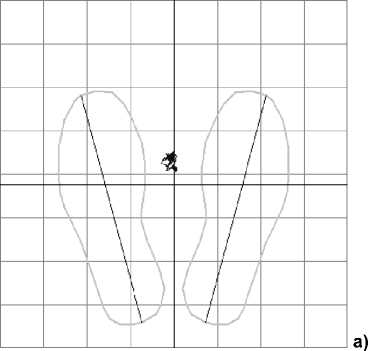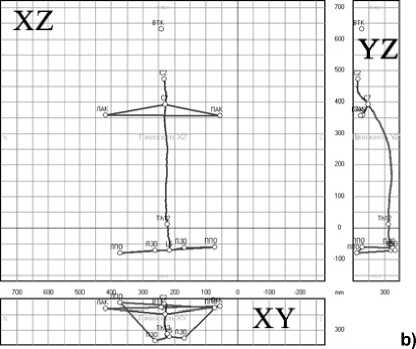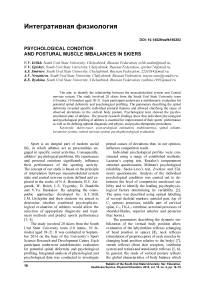Psychological condition and postural muscle imbalances in skiers
Автор: Erlikh V.V., Epishev V.V., Smirnov A.S., Nenasheva A.V., Ryabina K.E.
Журнал: Человек. Спорт. Медицина @hsm-susu
Рубрика: Интегративная физиология
Статья в выпуске: 2 т.15, 2015 года.
Бесплатный доступ
The aim: to identify the relationship between the musculoskeletal system and Central nervous system. The study involved 20 skiers from the South Ural State University team (10 males, 10 females) aged 18-21. Each participant underwent a stabilometric evaluation for potential spinal deformity and psychological profiling. The parameters describing the spinal deformity revealed specific individual postural features and allowed clarifying the cause of observed deviations in the vertical body posture. Psychological tests showed the psycho-emotional state of athletes. The present research findings show that individual physiological and psychological profiling of athletes is essential for improvement of their sports’ performance as well as for defining optimal diagnostic and physio- and psycho-therapeutic procedures.
Skiers-racer, post-urological estimation, stabilometriya, spinal column, locomotor system, central nervous system, psychophysiological evaluation
Короткий адрес: https://sciup.org/147153255
IDR: 147153255 | УДК: 159.9.072 | DOI: 10.14529/ozfk150203
Текст научной статьи Psychological condition and postural muscle imbalances in skiers
Sport is an integral part of modern social life, in which athletes act as personalities engaged in specific social activities. Consequently, athletes’ psychological problems, life experiences and personal emotions significantly influence their performance of the sporting activity. The concept of our study is based on the principle of interrelation between musculoskeletal system state and central nervous system defined and explored in the works of N.A. Bernstein, B.V. Zei-garnik, W. Reich, L.S. Vygotsky, D. Boadella and V.Yu. Baskakov. By adopting the osteopathic approaches developed by A.T. Still, J.M. Littlejohn and their students we aimed to determine whether combined psychophysiological evaluation of athletes would allow the selection of appropriate diagnostic and treatment methods and predict sports performance [3, 4].
The study involved 20 skiers from the South Ural State University team (10 males, 10 females) aged 18–21. It was conducted in September 2014 on the base of the University’s Sport Science Research and Development Centre. Each participant underwent astabilometric evaluation for potential spinal deformity and psychological profiling. Integrated analysis of physiological and psychological data was conducted to investigate primal causes of deviations that, in our opinion, influence competition result.
Individual psychological profiles were constructed using a range of established methods: Lazarus’s coping test, Rusalov's temperament structure questionnaire, Milman's psychological reliability, Sacks-Levy's test, Zverkov and Eidman's questionnaire. Analysis of the individual psychological condition was carried out to determine the level of competitive emotional stability and to identify the leading psychophysiological factors determining its variability [2]. The spine was described using optical labelling of several skeletal markers: parietal part, top of C 2 spinous processes, middle part of cervical spine, C 7 , Th 1 -L 5 vertebrae, acromial processes of shoulder-blades, superior anterior and posterior iliac horns.).
The parameters describing the dynamic stabilization of the vertical body position allow evaluation of the labyrinthine reflexes (changing of head position in space) [8], neck reflexes (stimulation of proprioceptors of neck muscles by changing head position relative to the body) [7], stretch reflexes (from skin receptors, vestibular system and retina) and statokinetic reflexes [5, 6]. In general, the study of vertical posture reflects the global characteristics of body balance which allows drawing conclusions on spinal functional disorders, the conditions of the nervous, vestibular and visual sensory systems, as well as assessing the condition of the muscles and joints in the lower extremities [1, 10]. Data on spatial position of spine, vertical stability and psycho-emotional state (162 parameters in total) were subjected to correlation and cluster analyses as well as statistical hypothesis testing and CART algorithm (Classification and Regression Tree) using Statis-tica version 10.0 software.
The parameters describing the spinal deformity revealed specific individual postural features and allowed clarifying the cause of observed deviations in the vertical body posture. Figure presents the vertical stability and the spine parameters of a 20-years-old skier. The centre of body mass displays a forward and leftward displacement combined with a relatively high level of oscillation. Most likely these deviations have been caused by spinal physiological curvature defects (i.e. thoracic hyperkyphosis and cervical hyperlordosis), different lengths of the lower extremities, and a probable hypertension of gastrocnemius and feet muscles [9]. Psycho-emotional profiling has revealed that the individual has suffered traumatic family experiences during early childhood. Analysis of athlete’s psychological condition revealed that despite his outstanding physical ability and high physical working capacity he is diffident, suffers significant fear of underachievement and presents high anxiety level, obvious self-control and low level of competitive emotional stability. Eventually, the athlete suffered a range of physical and emotional failures resulting in his poor performance during the Russian ski-racing championship (37th position).
According to Reich et al. [1, 2], we can hy- pothesise a high likelihood for an excessive muscle tension at several levels: cervical (hypertension of anterior neck muscles), thoracic (hypertension in chest muscles and weakness of their antagonists), lumbar (flattening of lumbar lordosis, hypertonia of lumbar paravertebral muscles) and pelvic (incorrect position of the pelvis, tension of lower extremity muscles). This example clearly shows close relationship between the successful competition performance, the psychological and the spinal conditions. The athlete was referred to specialists for sessions of osteopathic-and psycho-therapy including guided affective imagery and neuro-linguistic programming.
Statistical analysis of the data from all 20 athletes in the studied population of skiers revealed clear interrelations between the three main study variables that may further a llow developing of diagnostic criteria and predict athletic results. In particular, using t he method o f Classification and Regression Tr e e we observed signifi c ant correlations between the follo w ing physiological and psychological descriptors:
Young males (n 1 = 10): Cervical spine length – if t h e length is more than 71 mm, the athlete comes into social contacts more easily (social plas t icity); The angle between the nec k and the plane YZ in 3D – if the angl e is less than 97,5 degrees, the athlete has a bad attitude to his\her past (un s olved problems in childhood – attitude to the past ) ; The angle between the low back and the plane XZ in 3D – if the angle is more than 93,5 degrees, the athlete has ability for high self-regulation (multiple social taboos – self-regulation).
Young females (n 2 = 10): Thoracic spine length – if the length is more than 374. 5 mm, the athl e te has a low self-esteem (dissatisfaction with him - herself – unrealized opportunities); position


Example of an individual record from the stabilometric platform (a) combined with simultaneous registration of the spinal parameters (b)
Интегративная физиология of centre of gravity in sagittal plane – if the value is below – 3.62 mm, the athlete has positive attitude to the future and is committed to intense mental and physical work (attitude to the future).
In conclusion, the present research findings show that individual physiological and psychological profiling of athletes is essential for improvement of their sports’ performance as well as for defining optimal diagnostic and physio- and psycho-therapeutic procedures.
Список литературы Psychological condition and postural muscle imbalances in skiers
- Alexander N.B. Postural Control in Older Adults. Journal of the American Geriatrics Society, 1994, no. 42(1), pp. 93-108. DOI: DOI: 10.1111/j.1532-5415.1994.tb06081.x
- Baskakov V.I. Rossiyskaya telesno-orientirovannaya psikhoterapiya v litsakh . Moscow, Institute for Humanities Research Publ., 2006. 208 p.
- Boadella D. Lifestreams. An Introduction to Biosynthesis. Routledge, London University Press, 1987.
- Boadеlla D. Wilhelm Reich. The Evolution of his Work. London, University Press, 1973.
- Cenciarini M., Peterka R.J. Stimulus-Dependent Changes in the Vestibular Contribution to Human Postural Control. J. of Neurophysiology, 2006, no. 95, pp. 2733-2750. DOI: DOI: 10.1152/jn.00856.2004
- Clark S., Rose D.J. Evaluation of Dynamic Balance Among Community-Dwelling Older Adult Fallers: A Generalizability Study of the Limits of Stability Test. Archives of Physical Medicine and Rehabilitation, 2001, no. 82 (4), pp. 468-474. DOI: DOI: 10.1053/apmr.2001.21859
- Gribble P.A., Hertel J., Plisky P. Using the Star Excursion Balance Test to Assess Dynamic Postural-Control Deficits and Outcomes in Lower Extremity Injury: A Literature and Systematic Review. Journal of Athletic Training, 2012, no. 47(3), pp. 339-357.
- Kennedy A., Bugnariu N., GueveА., Sveistrup H. Adaptation of the Feedforward Postural Response to Repeated Continuous Postural Perturbation. Neuroscience & Medicine, 2013, no. 4(1), pp. 45-49. DOI: DOI: 10.4236/nm.2013.41007
- Remaud A., Boyas S., Lajoie Y., Bilodeau M. Attentional Focus Influences Postural Control and Reaction Time Performances Only During Challenging Dual-Task Conditions in Healthy Young Adults. Experimental Brain Research, 2013, no. 231(2), pp. 219-229. DOI: DOI: 10.1007/s00221-013-3684-0
- Ryabina K.E., Epishev V.V. . Bulletin of South Ural State University. Ser. Education, Healthcare Service, Physical Education,2014, no. 4(14), pp. 68-73.
- Skvortsov D.V. Klinicheskiy analiz dvizheniy. Stabilometriya . Moscow, JSC Antidoron, 2000. 192 p.


